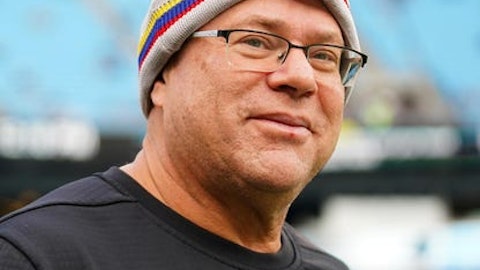Operator: Our next question comes from James Heaney with Jefferies. Please go ahead.
James Heaney: Thanks for the questions. I would love to hear a little bit more about just what you’re seeing in Japan. Are there any things that Malgosia and the APAC team are focused on to reaccelerate growth in that market specifically? I mean, it sounds like a payers brand campaign is in motion, but curious if there’s anything else that the team has planned. Thanks.
Bernard Kim: Thanks, James. Great question. The Japanese market has remained challenging for us. What we can do is put the right team in place, and we’re really excited about the new CEO that has joined us and is overseeing Pairs. I think he’s going to do a really fantastic job. In tandem with that, it’s really great that Malgosia is on the ground running the business. And she really has hit the ground running, meeting with all the different teams and then instituting product changes that I think will be impactful in the marketplace. So, we’re exploring all the different options that we can do to jumpstart the business in Japan. But what we’re really excited about in the short term is being able to advertise for the first time on TV in Japan.
We actually believe that this channel unlock could be really meaningful. And you’re right in saying that we are ready, the second that, that is available with the Pairs marketing campaign that we’re really excited about to be on television for the first time. Thanks for the question.
James Heaney: Thank you.
Operator: Our next question comes from Brian Fitzgerald with Wells Fargo. Please go ahead.
Brian Fitzgerald: Thanks. On Archer, we wanted to ask if you could provide any specifics on the rollout? And how you’re approaching that from a marketing perspective? And any early indications around the strength of the product market fit? Thanks.
Bernard Kim: Thanks, Brian, for the question. We’re really proud of the Archer team and the experience that we’re providing for gay daters. When it comes to an indication on how it’s performing, it’s still really early. It’s only been live in the New York market for about 10 days, but daters are happily creating profiles right now. Our plan continues to be that we plan to roll out nationwide by the end of this year. When it comes to marketing, I’m really inspired by the approach that the team has taken. They’re doing events with social influencers. They just recently had a big event on Fire Island in New York City, and we’re really excited about the creative marketing efforts that the teams are executing against. Thanks for the question.
Brian Fitzgerald: Thanks, BK.
Operator: Our last question comes from Jason Helfstein with Oppenheimer. Please go ahead.
Jason Helfstein: Hey, thanks for getting me back in. I should have played Mega Millions, I guess, I’ll hit the earnings call lottery getting both at the same time. Just a quick question on weekly subs. So, if the mix of weekly subs increases, does that increase churn? And how do you think about managing your outlook if there’s less visibility around churn? And then, how do you — is it a weekly package more like à la carte? And historically, Europe was more à la carte already. Just — maybe just broadly, how are you thinking about that? Thank you.
Gary Swidler: Sure. Let me take that one. First of all, it’s important to point out that weekly subs are new to us, and we’re still learning from the trends we’re seeing there, especially around renewals. We don’t have as much data as we’d like. Obviously, we have much more data around monthly subscriptions and longer-term packages. So, you’re right, it’s newer, it’s harder to manage, it’s harder to determine the outlook. We’ve gotten better at it just over the last few months, and we’ll continue to get better at it as we get more data and time goes on. And it’s also important to point out that we don’t really manage our outlook or we don’t provide an outlook based on payers and revenue per payer. We provide it based on revenue, where we have a lot better visibility because, frankly, the revenue impact from the weekly subs has been much, much more stable.
It has been the impact on the payer count that has been more challenging to analyze. So, we’re providing the best outlook we can on payers and RPP drivers within revenue because people keep asking us about it. But the reality is we don’t look at it that way as much as we do on the revenue side. That’s what we’re targeting. So, it has introduced more variability. It has made things more complicated. I do think it will get better. And you’re also right, there is more churn. These people come on for a short time, they go off. And so, we’re seeing that dynamic. But the good news is the conversion rates are up, the renewal rates are strong, and it is helping especially with younger users who are really liking the weekly subscription packages. And so that’s a real positive for the business.
And also, I’d point out that all of this is a testing process. The business is a dynamic business. We’re constantly readjusting. We’ve introduced this new type of subscription package now, and there has been real demand for it. And so, we need to keep testing. And so right now, we’re giving our best outlook for Q3 in terms of payers being better than they were sequentially than in Q2. It’s still early to say what the impact is going to be on Q4. There’s a lot of variables around kind of all these things working themselves through the payer system. But what I can tell people with a lot of certainty is the revenue growth is accelerating, and that’s the main thing that we care about and are focused on. The revenue per payer is accelerating. And some of this variability is going to be reduced as we get towards the end of this year.
So that will make things a little bit more kind of clearer from a visibility standpoint. And we’ll provide as much updates and information as we can. But I would discourage people from using payers as a proxy for top-of-funnel strength. What we’re seeing and what indicates that there is top-of-funnel strength is improvement in the new registrations or new user sign-ups and reactivation. And we provided that chart in the letter, which clearly indicates that a 10% year-over-year improvement from a growth rate perspective in those top-of-funnel metrics. That’s showing us that we’re bringing in more people in, which is very critical, and we’re going to continue to drive marketing and product initiatives to do that, which should continue to help us grow from a top-of-funnel perspective.
Obviously, we can continue to convert those people and that will ultimately drive payers, and that’s something we’re going to — we’re expecting to see over the coming quarters, which will help drive payers and ultimately contribute to revenue. That is the metric that we’re focused on to see the overall health of the business. The payers, we can impact that by pricing decisions we make and product decisions we make. If we rolled out $1 subscription, the payer numbers would go up, but it might not be revenue enhancing. So, we’ve got to consistently test and adjust to drive overall revenue for the business, not specifically a metric like payers or even RPP. And that’s the way that we think about the business and think about how to drive long-term value for shareholders.
Jason Helfstein: Thank you.
Gary Swidler: Hopefully, that’s helpful, Jason. We are glad you’re safe and were able to join the call. And we thank everyone for joining this morning, and we look forward to talking to you all again on the next earnings call. Thank you so much.
Operator: The conference has now concluded. Thank you for attending today’s presentation. You may now disconnect.
Follow Match Group Inc. (NASDAQ:MTCH)
Follow Match Group Inc. (NASDAQ:MTCH)
Receive real-time insider trading and news alerts





